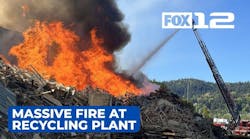ALPENA, Mich. (AP) -- From 6,000 feet above the ground and no water, a different breed of firefighters fight fires by detection and giving information.
''For the fire response team, the best thing they can hear is 'We've got you in sight' so we can steer them to the fire,'' said William Green, a Michigan Department of Natural Resources pilot.
A Hillman resident, Green began as a contract pilot for the DNR in 1983 and became lead pilot for the state in 1993.
''I wouldn't change my job for anything,'' he said.
Detection, giving fire and smoke information, directions to the fire area and where the equipment can unload, and evacuation are all part of a day's work for the pilots.
They also stay with the fire, aiding the ground crew until the fire is contained or suppressed.
''It is strenuous. You get so wound up, especially when you have structures with people and people's lives involved,'' Green said. ''When you get home you're so tired, but you can't sleep for a while.''
When Green receives a report of a fire from the DNR dispatch in Roscommon or sees a smoke column, it is his responsibility to fly over it and report back the location, size and type of fire so the ground crew knows what to bring and how to fight it.
''They help us out a lot. It's another tool we use,'' said fire officer Lee Osterland.
''We are their eyes,'' Green said. ''They don't know where to turn or how big the fire is. We can give them that information.''
As pilots fly over smoke and fires, they check to see whether it is a hardwood, pine or grass fire, since each has its own properties and behavior.
The state has eight aircraft that patrol from Grand Rapids north to the Mackinac Bridge throughout the fire season. While five are owned by or contracted to the DNR for state land, three are U.S. Forest Service and patrol over national forest land.
Urban areas with little or no state land and bigger fire departments are not covered.
Pilots normally go up between 1 p.m. and 6 p.m. during high fire season, flying at about 4,000 to 6,000 feet. In extremely high danger conditions, pilots may go up before 1 p.m. and stay up later.
''You adjust depending on the weather conditions,'' Green said.
Since pilots have no specific detection pattern, Green tells them to use their own skills and knowledge while flying. ''Usually we try to sit in the middle of our areas on a clear day,'' he said.
Pilots can also help when the DNR brings in bulldozers to contain a fire. But with strong winds, the fire can jump over the line and come up behind the crews unexpectedly.
''The fires can get going pretty fast,'' Green said, adding especially in jack pine areas that can burn over 6,000 acres in one day. ''Jack pines are very volatile.''
As Green flies over his detection area, several ''scars'' are apparent, even after a decade of growth, from major fires in the past.
On the ground, township fire departments usually arrive first because they are often closer. The DNR pilots also help guide township crews' equipment to where it should be.
While the pilots are out during peak season and on high fire danger days, Green said many calls come from members of the public who spot fires, especially near their homes or camp sites.
''Everybody's nervous. If they smell smoke, they call us,'' Green said. Most of the fires begin with debris or trash burning, with or without a permit issued by the DNR, he added.
If a person starts a fire, permit or not, they are charged for the costs of suppression, which can range from $10,000 to $20,000.
While DNR pilots' primary mission is fire detection, they conduct surveillance for illegal deer baiting and illegal off-road vehicle traffic and help out with surveys the rest of the year.





